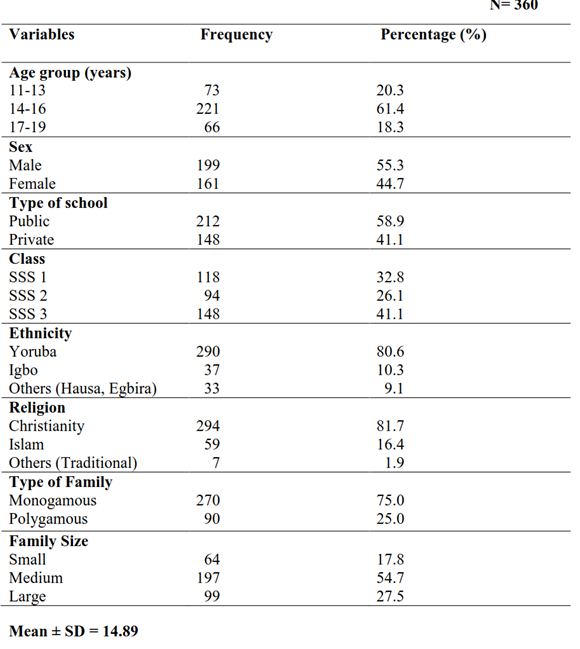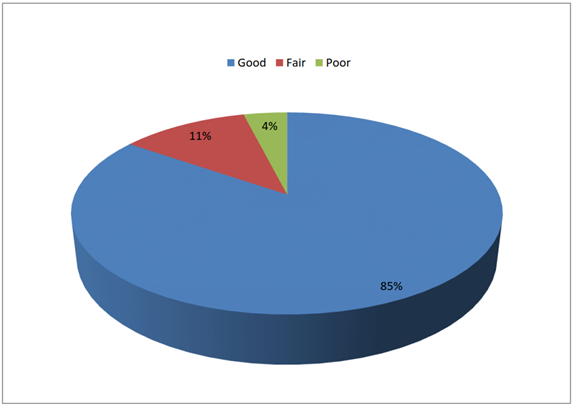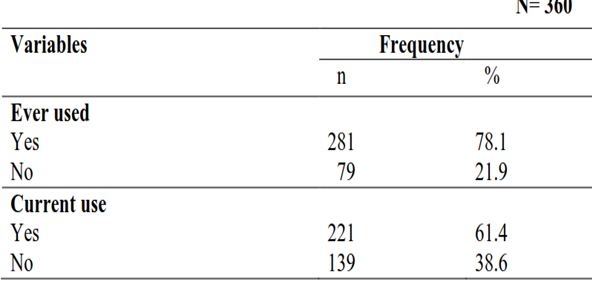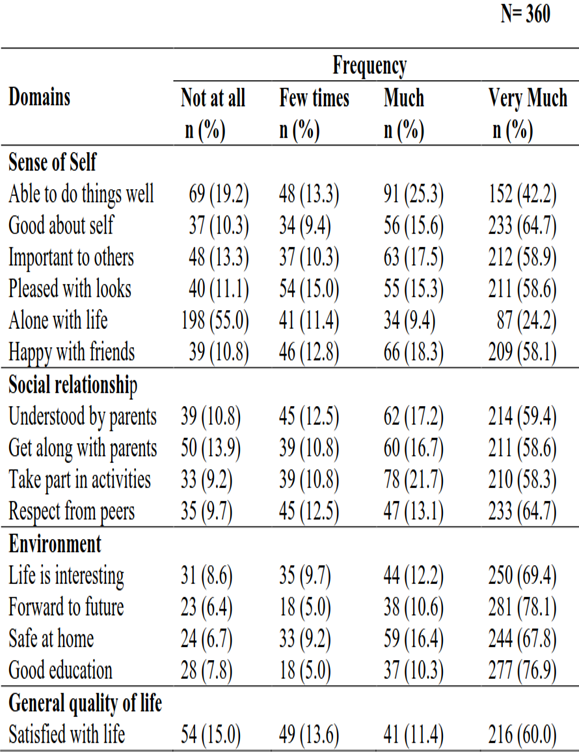Research Article
Volume 2 Issue 1 - 2020
Prevalence of Psychoactive Substances Use and Quality of Life of Adolescents in Secondary Schools in Akoko North East Local Government Area On do State
1MPH; Community Health Department, Obafemi Awolowo University, Ile-Ife, Nigeria
2PhD; Community Health Department, Obafemi Awolowo University, Ile-Ife, Nigeria
3MPH, Department of Mental Health, Obafemi Awolowo University, Nigeria
4MPH; Community Health Department, Obafemi Awolowo University, Ile-Ife, Nigeria
5MSc (PT), Physiotherapy Department, University of Medical Sciences, Ondo, Nigeria
6MPH, Community Health Department, Obafemi Awolowo University, Ile- Ife, Nigeria
2PhD; Community Health Department, Obafemi Awolowo University, Ile-Ife, Nigeria
3MPH, Department of Mental Health, Obafemi Awolowo University, Nigeria
4MPH; Community Health Department, Obafemi Awolowo University, Ile-Ife, Nigeria
5MSc (PT), Physiotherapy Department, University of Medical Sciences, Ondo, Nigeria
6MPH, Community Health Department, Obafemi Awolowo University, Ile- Ife, Nigeria
*Corresponding Author: Balogun Ayodeji Joseph, MPH; Community Health Department, Obafemi Awolowo University, Ile-Ife, Nigeria.
Received: March 17, 2020; Published: March 24, 2020
Abstract
Objective: This study assessed the knowledge of secondary school adolescents on health effects of psychoactive substances, assessed the quality of life of the secondary school adolescents. It also determined association between use of psychoactive substances and quality of life.
Methods: A crosssectional descriptive survey study conducted among secondary school adolescents in Akoko North East Local Government Area Ikare Akoko, Ondo State, Nigeria. Multistage sampling technique was used to select 360 respondents from four public and three private senior secondary schools. An interviewer-administered questionnaire was used to collect data on socio-demographic characteristics of the respondents, knowledge on psychoactive substances and its health effects of psychoactive substances and use of psychoactive substances. The youth quality of life questionnaire was used to collect information on respondents’ quality of life. The data were analyzed using the Statistical Package for social sciences (IBM Version 20). The data were subjected to univariate and bivariate analyses. Tests of association were conducted using chi-square test. The level of significance was determined at p-value less than 0.05.
Results: Majority of the respondents had good knowledge on the health effects of psychoactive substance. Fifty-nine percent (55%) of the respondents had high quality of life while 41.1% had low quality of life. There is significant association between age-group and current use of psychoactive substance. There is also a significant association between knowledge of health effects and current use of psychoactive substances. The proportion of students who use psychoactive substances with poor quality of life are similar with the proportion of students who do not use psychoactive substances.
Conclusion: The study concluded that there is high proportion of secondary school student who use psychoactive substance and this had no influence on their quality of life.
Key words: Psychoactive Substance; Quality of Life; Adolescence
Introduction
Substance use refers to the inappropriate consumption or use of psychoactive substances, including alcohol and illicit drugs (WHO, 2014). Psychoactive substance use can lead to dependence syndrome - a cluster of behavioural, cognitive, and physiological phenomena that develop after repeated substance use and that typically include a strong desire to take the drug, difficulties in controlling its use, persisting in its use despite harmful consequences, a higher priority given to drug use than to other activities and obligations, increased tolerance, and sometimes a physical withdrawal state (WHO, 2014).
Worldwide, an estimated 167-315 million people between the ages of 15-64 use illicit substances (World Drug Report, 2013). Although the prevalence of some drug use has largely decreased over the past decade, the overall use of illicit substances in the United States has been slightly on the increase (SAMHSA, 2012). Substance use has become a major public health issue (Owoaje and Bello, 2010). The people particularly vulnerable to substance abuse include the abused or neglected youths, the homeless, the physically or mentally challenged, school drop outs, children of substance abusers, street children and the economically disadvantaged (Room, 2006). Tobacco use has become a rapidly growing problem worldwide as well as in many developing countries. It is projected that over the next 50 years close to 450 million deaths would be caused by tobacco use (CDC, 2005).
Igwe and Ojinnaka identified alcohol, kolanut and coffee as the substances most commonly used among adolescents in Nigeria (Igwe and Ojinnaka, 2010). While it has been established that many smokers start before the age of 18 years (Yisa et al., 2009),of serious concern is the increasing trend in smoking amongst youths and the likelihood that many of these young people who begin to smoke at an early age, will continue to do so throughout adulthood (Osungbade et al., 2008).
The use of illicit and controlled substances in addition to excessive use of alcohol is strongly influenced by many factors, including: age, gender, family history, and the presence of co-occurring psychiatric disorders (Oshodi et al., 2010). Many additional factors, including: race, geographic location, arrest history, and age at first use of drugs predispose individuals to drug abuse (Staff, 2012). Factors associated with increasing uptake of cigarette among youths include low self-esteem, stressful life events, friends who smoke, advertisement and living with a smoker (Odeyemi et al., 2009). Parental deprivation due to deaths, divorces, separation or discord has also been strongly associated with substance abuse (Odejide, 2000). The general Quality of Life domain which is common to all age groups include physical, psychosocial and social.
The adolescent have specific domains, such as physical maturation, body image, intimacy/sexuality, autonomy, and peer relations which is specific to them (Frisén, 2007). These domains are believed to be very sensitive to some risk factors. Among the risk factors identified were older age, lower socioeconomic status, and health-risk behaviours, such as alcohol and tobacco use and high-risk sexual behaviours. These factors have been found to have significant impacts on adolescents’ health and QOL (Johnson & Richter, 2002; Ravens-Sieberer, Nickel, et al., 2006). A study conducted among adolescents on substance use and QOL reported that there was a significant association between substance use and quality of life (Frisen, 2007). Another study conducted among adolescents reported that moderate reduction in use of psychoactive substances was associated with high QOL (Becker et al., 2009).
Substance Abuse and Mental Health Service Administration (SAMSHA) reported a lower rate of illicit substance use among adolescents from 8.9% in 2002 to 5.2% in 2013 in the United States (SAMSHA, 2013). Marijuana continues to be the most commonly used illicit drug in America. In 2013, 19.8 million or 7.5% of Americans age 12 and older were current users of marijuana (SAMSHA, 2013).
The United Nation Office on Drug and Crime reported that Nigeria is one of the highest consumers of cannabis and amphetamine in Africa (UNODC, 2011). In Nigeria the estimated lifetime consumption of cannabis among the population is 10.8%, stimulants (10.6%), heroin (1.6%) and cocaine (1.4%) (UNODC, 2011). A study on the pattern of substance abuse among senior secondary school students in a South-western city of Nigeria reported that the commonly used substances were analgesics (46.7%), cannabis (16.7%), tobacco (14.3%) and inhalers (14.0%) while 8.3%, 7.4%, and 6.4% of the respondents were found to be using alcohol, sedatives and solvents respectively (Atoyebi and Atoyebi, 2013). Another study conducted on quality of life in alcoholic males reported that males with more severe alcohol dependence perceive their own quality of life as worse (Silva et al., 2005). Over the years, great attention has been placed on Quality of life/Health related quality of life (QOL/HRQOL) research in children and adolescents, and with the greatest progress in the development of regulatory issues for assessments (De Civita et al., 2005; Ravens-Sieberer et al., 2006; Solans et al., 2008). A research conducted among young heroin users on gender differences and quality of life in Spain reported that the quality of life of users is worse when associated with the consumption of multiple drugs, especially among younger, lesser-educated, and unemployed individuals (Domingo-Salvany et al., 2010).
Previous research conducted among adolescents in Sweden reported a significant association between substance use and QOL (Frisen, 2007). A research conducted in Brazil among adolescents on substance use showed greater impairment in quality of life in all areas, as well as more symptoms of anxiety and depression (Castro et al., 2007). Another research conducted in Belgium among adolescents revealed that moderate reduction in the frequency of substance use among adolescent was associated with improvement in QOL (Becker et al., 2009). A study conducted among adolescents in low and middle income countries assessing relationship between alcohol/drug use and quality of life (QOL) reported that substance use was significantly associated with lower levels of quality of life (Dejan et al., 2015).
Many of the studies done in Nigeria were on psychological correlates of substance use, pattern of substance use and prevalence of substance use. There is limited information on association between psychoactive substance use and QOL of the adolescents especially the in-school adolescents in Nigeria. Hence this study.
Methods
363 participants who are adolescent aged range 11-19 years, were recruited for this crosssectional descriptive survey study. This study was carried out in Akoko North East Local Government Area, in Ondo State, Nigeria. A two-stage sampling technique was employed. In the first stage, four public senior secondary schools and three private senior secondary schools were selected from 16 public and 13 private secondary schools in Akoko North East Local Government Ondo State by simple random sampling technique. The second stage involved selection of eligible respondents per class by simple random sampling technique. A semi-structured interviewer administered questionnaire was used to collect data. The questions were in three (3) sections; Section A: sought socio-demographic information of the respondents. Section B: collected information on knowledge of psychoactive substances and their health effects. Section C: collected information on the use of psychoactive substances by the respondents.
The Youth Quality of life Short Form (YQOL- SF) questionnaire was used to collect information on the quality of life of respondents. The youth quality of life instrument –Short-Form (YQOL- SF) measures generic quality of life in youth ages 11-18years with and without chronic conditions and disabilities. The short form includes 15 perceptual items measuring the domains of sense of self, social relationships, environment, and general quality of life. This instrument was developed by asking youth about both positive and negative aspects of QOL. The YQOL-SF is designed for monitoring leading indicators of QoL in adolescent population, and is not scored by domain, as each question is regarded as a social indicator in itself. The YQOL-SF scores are transformed to a 0-100 scale for easy interpretability, higher scores indicating better QoL (Patrick, Edwards and Topolski, 2001).
Table 1: The mean age was 14.89 (SD= 1.88) years, the range of 11-19 years. Sixty-one percent of students were within age group 14-16years. There are 199 males (55.3%) and 161 females (44.7%). Fifty-nine percent of the respondents attend public schools while 41.1% attends private Schools. Two hundred and seventy (75.0%) were from monogamous family.
Table 2 illustrated that Thirty-seven percent of the respondents defined psychoactive substances as substance that contains chemicals, 22.2% reported them as harmful substances and 13% reported them as substances that changes mood. The most commonly mentioned psychoactive substance by respondents was alcohol (86.1%), followed by tobacco/cigarette (70.6%) and opioids (59%) Eighty-five percent of the students had good knowledge of psychoactive substances, 11% had fair knowledge while 4% had poor knowledge. (Figure 1). Seventy-eight percent of the students had ever used psychoactive substances and 61.4% of the students are current users

Table 6: Association between Quality of Life of Secondary School Students and current use of Psychoactive Substance.
The proportion of respondents (81.6%) that had ever used psychoactive substances with high quality of life was slightly higher than proportion of respondents (73.0%) with low quality of life (χ2 = 4.790, p = 0.052).
Discussion
This study showed that majority of the respondents had good knowledge of psychoactive substances and this might be attributed to the regular advertisements on some of the psychoactive substances in the media, religious institutions, and schools that continuous use of such substances is injurious to their health. The finding was in disagreement with report of poor knowledge of psychoactive substance among secondary school students in Ilorin (Olaitan, 2006). The finding was in disagreement with previous reports of poor knowledge of psychoactive substance use among secondary school students in Lagos (Oshodi et al., 2010). The finding was also in disagreement with reports of poor knowledge of psychoactive substance use in a study among secondary school students in Anambra (Nwankwo et al., 2013). The present finding was in disagreement with report of low prevalence of substance use conducted among secondary school students in Nigeria (Fatoye and Morakinyo, 2002).
The present study reported alcohol, mild stimulants and hard drugs were commonly used. The finding was supported by reports of alcohol, mild stimulants as substances commonly used in a study conducted in Lagos among secondary school students (Fatoye and Morakinyo, 2002). It was also in agreement with reports of mild stimulants, alcohol and tobacco as the commonly used drugs in a study conducted among medical students in a Nigerian University (Makanjuola, Daramola and Obembe, 2007). However, It was in disagreement with reports of caffeine, mild analgesics and antimalarial as the commonly used substances in a study conducted on substance use among secondary school students in Lagos state, Nigeria (Oshodi, Aina and Onajole, 2010).
The low prevalence of hard drugs (cocaine, heroin, Opioids) observed was supported by findings of low prevalence of these substances among secondary school students in Osogbo (Atoyebi and Atoyebi, 2013). The low prevalence of hard drugs among the students was in agreement with low prevalence of substance use in a study carried out on prevalence of substance use among senior secondary school students in Lagos (George, 2014). This study showed that majority of the respondents had high quality of life.
The present finding was in agreement with the report of a high quality of life in a study conducted among adolescents in low-income countries (Dejan et al., 2015). The study showed that adolescents in private schools had higher quality of life compared to those in public schools. This finding was supported by reports of higher quality of life among private school students in a study carried out amongst adolescents in Northern India (Awasthi et al., 2011). The study showed that male students who are nonuser of psychoactive substances have higher quality of life compared to female students. This finding was supported by higher quality of life among male adolescents in a study conducted in low-income countries (Dejan et al., 2015). The present study showed that the quality of life of secondary school students who had ever used psychoactive substances was higher. This finding was in agreement with reports of high quality of life among adolescents in developed countries who use psychoactive substances (Nickel, et al., 2006; Topolski et al., 2001; Zullig et al., 2001).
Conclusions
Majority of the students had good knowledge of psychoactive substance use and its health effects. The prevalence of psychoactive substance use among secondary school adolescents was high. The age of the adolescents and type of schools attended significantly influence current psychoactive substance use. Students who are current users of psychoactive substance have low quality of life.
References
- Atoyebi O. A and Atoyebi O. E., (2013). Pattern of Substance Abuse among Senior Secondary School Students in a Southwestern Nigerian City. International Review of Social Sciences and Humanities. pp. 54-65.
- Awasthi S., Agnihotri K., Singh U., Savitri T., Chandra H., (2011). Determinants of health related quality of life in school-going adolescence in Northern India. Indian J pediatr. 78:555.
- Becker, S. J., Curry, J. F., & Yang, C. (2009). Longitudinal association between frequency of substance use and quality of life among adolescents receiving a brief outpatient intervention. Psychology of Addictive Behaviors, 23(3), 482–490.
- Bello, J & Owoaje, E. T. (2010): Psychoactive Substances Use among Undergraduate Students of the University of Ibadan, Nigeria. Tropical Journal of Health Sciences; 17(2): 40-46.
- Castro M. G, Oliveira M. S, Moraes J. D, Miguel A. C, Araújo R. B., (2007). Quality of life and severity of tobacco dependence. Revista de Psiquiatria Clínica; 34(2): 61-67.
- Centers for Disease Control and Prevention, (2007). Tobacco Use Prevention through Schools, May 8.
- De Civita, M., Regier, D., Alamgir, A. H., Anis, A. H., Fitzgerald, M. J., & Marra, C. (2005). Evaluating health-related quality-of-life studies in paediatric populations: Some Conceptual, methodological and developmental considerations and recent applications. PharmacoEconomics, 23(7), 659–685.
- Dejan S, Olayinka A, Yatan P, et al., (2015). The Relationships between Alcohol/Drug Use and Quality of Life among Adolescents: An International, Cross-Sectional Study, Journal of Child & Adolescent Substance Abuse, 24:4,177-185.
- Domingo-Salvany A, Brugal M. T, Barrio G, González-Saiz F, Bravo M. J, La Fuente L, (2010). ITINERE Investigators. Gender differences in health related quality of life of young heroin users. Health Qual Life Outcomes; 8: 145.
- Edwards T. C, Huebner C. E, Connell F. A, et al., (2001). Adolescent Quality of Life, Part I: Conceptual and Measurement Framework. J Adolescence 2001. In press.
- Fatoye, F. O. (2007). Substance use among university undergraduates. A study of pattern and beliefs in Ile-Ife. Nigerian Postgraduate Medical Journal. 14; 37-41.
- Fatoye F. O, and Morakinyo O., (2002). Substance use among secondary school students in rural and urban communities in South Western Nigeria. East African Medical Journal; 79; 6: 299-305.
- Frisén, A. (2007). Measuring health-related quality of life in adolescence. Acta Paediatrica, 96(7), 963–968.
- Geroge N. A., (2014). Prevalence of substance abuse among senior secondary students in mainland local government, Lagos. Global J. Med and Public Health, 98(6): 2277-9604.
- Igwe W. C, Ojinnaka N. C., (2010). Mental health of adolescents who abuse psychoactive substances in Enugu, Nigeria - a cross-sectional study. Ital. J Pediatr; 36: 53.
- Johnson, P. B., and Richter, L. (2002). The relationship between smoking, drinking, and adolescents’ self-perceived health and frequency of hospitalization: Analyses from the 1997 National Household Survey on Drug Abuse. Journal of Adolescent Health, 30(3), 175–183.
- Makanjuola A. B. Abiodun O. A. and Sajo S., (2014). Alcohol and psychoactive substance use among medical students of the University of Ilorin, Nigeria. European Scientific Journal: 1857 – 7881.
- Makanjuola, A. B., Daramola, T. 0 and Obembe, A. 0. (2007). Psychoactive substance use among medical students in a Nigerian university. World Psychiatry, 6(2): 112-114.
- Nwankwo, C. A., Obi, J. S., Obi, I. & Nwosu, I. (2013): Secondary School Students Knowledge of the dangers associated with alcohol, tobacco and marijuana in Anambra State, Nigeria. Research Journal in Organisational Psychology and Educational Studies. 2(4): 179-184.
- Odejide, A. O. (2000). Observation on drug abuse in Western Nigeria, Africa. Psychol, 15 (80); 113-128.
- Odeyemi K. A, Osibogun A., Akinsete A. O, Sadiq L., (2009). The Prevalence and Predictors of Cigarette Smoking among Secondary School Students in Nigeria. Niger Postgrad Med J; 16(1):40-5.
- Oshodi O. Y, Aina O. F, Onajole O. T., (2010). Substance use among secondary school students in an urban setting in Nigeria: prevalence and associated factors?. African Journal of Psychiatry.Vol.13; pp 52-67.
- Osungbade K. O, Oshiname F. O., (2008). Determinants of cigarette smoking among senior secondary school students in a rural community of southwest Nigeria. Niger J Med; 17(1): 40-4.
- Patrick D. L, Edwards T. C, Topolski T. D., (2001). Adolescent Quality of Life, Part II: Initial Validation of a New Instrument. J Adolescence 2001. In press.
- Ravens-Sieberer, U., Erhart, M., Wille, N., Wetzel, R., Nickel, J., & Bullinger, M. (2006). Generic health-related quality-of-life assessment in children and adolescents: Methodological considerations. PharmacoEconomics, 24(12), 1199–1220.
- Room R., (2006), Taking account of cultural and societal influences on substance use diagnoses and criteria, Addiction, 101(Suppl. 1): 31-39.
- SAMA Foundation, (2014). The Effects of Drugs on the Adolescent Brain. Retrieved on August, 21, 2014.
- Solans, M., Pane, S., Estrada, M. ., Serra-Sutton, V., Berra, S., Herdman, M., Rajmil, L. (2008). Health-related quality of life measurement in children and adolescents: A systematic review of generic and disease specific instruments. Value in Health, 11(4): 742–764.
- Staff, K., (2012). Drug use on the rise among Nigerian youths?.Online Nigeria News : 2012.
- Stevanovic, D. (2013). Impact of emotional and behavioral symptoms on quality of life in children and adolescents. Quality of Life Research, 22(2): 333–337.
- Substance Abuse and Mental Health Service Administration (SAMSHA) (2012). Results from the 2010 National Survey on Drug Use and Health: Volume 1. Summary of National Findings. Rockville, MD: Office of Applied Studies, SAMSHA. Retrieved June 2012.
- Substance Abuse and Mental Health Service Administration (SAMSHA) (2013). Results from the 2011 National Survey on Drug Use and Health: Volume 1. Summary of National Findings. Rockville, MD: Office of Applied Studies, SAMSHA. Retrieved June 2013.
- Substance Abuse and Mental Health Services Administration (SAMSHA) (2011). National Household Survey on Drug Abuse: Population Estimates 2010. Rockville, MD: SAMHSA, Office of Applied Studies 2011.
- Topolski, T. D., Patrick, D. L., Edwards, T. C., Huebner, C. E., Connell, F. A., & Mount, K. (2001). Quality of life among adolescents engaging in health risk behaviors. Journal of Adolescent Health, 29: 426–435.
- United Nations Office on Drugs and Crime. (2007). Drug Abuse and Drug Dependece Treatment Situation, in Nigeria. Accoding to UNODC data for the year 2007.
- United Nations Office on Drugs and Crimes. (2016). World Drug Report UNODC (2011): Drug Prevention and Care.
- World Health Organisation. (2014). Global information system on alcohol and health (GISAH); 2014.
- Yisa I. O, Lawoyin T. O, Fatiregun A. A, Emelumadu O. F, (2009). Pattern of substance use among senior students of command secondary schools in Ibadan, Nigeria. Niger J Med, 2009; 18(1): 98-102.
- Zullig K. J, Valois R. F, Huebner E. S, Oeltmann J. E, Drane J. W., (2001). Relationship between Perceived Life Satisfaction and Adolescents' Substance Abuse. J Adolesc Health 2001; 29(4): 279-288.
Citation: Balogun Ayodeji Joseph. (2020). “Prevalence of Psychoactive Substances Use and Quality of Life of Adolescents in Secondary Schools in Akoko North East Local Government Area On do State”. Journal of Medicine and Surgical Sciences 2.1.
Copyright: © 2020 Balogun Ayodeji Joseph. This is an open-access article distributed under the terms of the Creative Commons Attribution License, which permits unrestricted use, distribution, and reproduction in any medium, provided the original author and source are credited.






